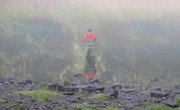Colorado regulations dictate that you may fish year round for trout, during the daytime and the nighttime using any methods deemed legal, unless specific waters have other regulations concerning them. Among the trout that inhabit the lakes, ponds, and flowing waterways of Colorado are the cutthroat trout, the lake trout, the brown trout, the brook trout and the rainbow trout. Regulations enforced by the Colorado Division of Wildlife cover many aspects of trout fishing in the state.
Length Regulations
In Colorado, there is no minimum length enforced for trout in most of the waters within the state. However, certain waters do impose a minimum length for various types of trout. A case in point is in the section of the Blue River that flows through the Blue River State Wildlife Area, the trout must be no less than 16 inches long to be keepers. Sometimes individual trout species are the subject of special minimum length regulations. On Grand Lake in Grand County, if you keep the maximum number of lake trout—four--only one can exceed 36 inches in length. In Jackson County, Colorado’s Delaney Butte Lakes, you cannot possess brown trout between 14 and 20 inches, nor rainbow and cutthroat trout in the 18 to 22 inch size range; you must quickly let them go after catching them.
Possession Regulations
The daily possession limit statewide for trout is four fish, with these trout all one species or a combination of species that equals four. However, many different venues in the state do have a specific regulation regarding the number of trout you may keep. Examples of these are the Upper and Lower Agnes Lakes in Jackson County, where you may keep only two trout per day. When angling in Grand County’s Arapaho Creek, you may possess just two trout per day. The Aurora Reservoir in Arapahoe County has a two trout limit. Other waters have regulations stating that you cannot keep the trout caught from them. This includes the portion of the Blue River from the Green Mountain Reservoir Dam to where the river flows into the Colorado River.
Cutthroat Regulations
Colorado trout regulations designate a large number of areas as Cutthroat Conservation and Recreation fishing waters. You may fish for trout in these waterways and lakes, but your bait has to be either artificial lures or artificial flies. Furthermore, you cannot keep any cutthroat trout that you manage to catch. Instead, their immediate and safe release is mandatory in these waters. The idea behind this release is to create a cutthroat fishery where larger fish occur.
Writer Bio
John Lindell has written articles for "The Greyhound Review" and various other online publications. A Connecticut native, his work specializes in sports, fishing and nature. Lindell worked in greyhound racing for 25 years.



